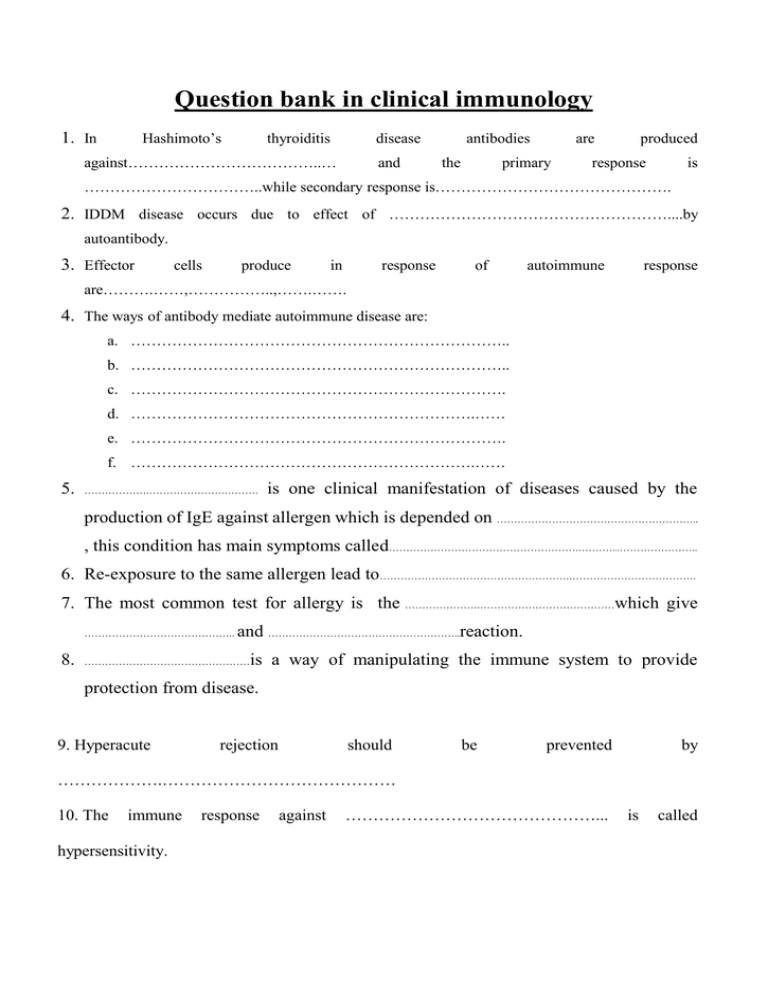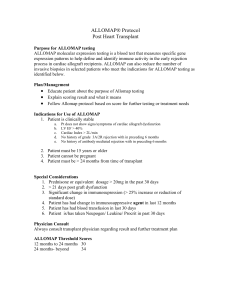بنك اسئلة مناعة سريرية
advertisement

Question bank in clinical immunology 1. In Hashimoto’s thyroiditis disease against………………………………..… and antibodies the are primary produced response is ……………………………..while secondary response is………………………………………. 2. IDDM disease occurs due to effect of ………………………………………………....by autoantibody. 3. Effector cells produce in response of autoimmune response are……….……,……………..,…….……. 4. The ways of antibody mediate autoimmune disease are: a. ……………………………………………………………….. b. ……………………………………………………………….. c. ………………………………………………………………. d. ………………………………………………………….…… e. ………………………………………………………………. f. ………………………………………………………….…… 5. ……………….………………….………. is one clinical manifestation of diseases caused by the production of IgE against allergen which is depended on ………………………………………………….. , this condition has main symptoms called……………………………………………….…………………………….. 6. Re-exposure to the same allergen lead to……………………………………………….………………………………. 7. The most common test for allergy is the ………………….…………………………………which give …………………………………….. 8. and ………………………………………………..reaction. ………………………………………… is a way of manipulating the immune system to provide protection from disease. 9. Hyperacute rejection should be prevented by ……………….…………………………………… 10. The immune hypersensitivity. response against ………………………………………... is called 11. In autoimmune haemolytic anemia autoantibodies are produced against ……………………… 12. Hypothyroidism in infant lead to …………..……………………. which is the retardation of …………………………..…………….……. and …………..……….……………………. growth 13. Deposition of antibody and complement in affected tissue detected ………………………………....……….. by or ……………………………………………………….. 14. In SLE disease the ways of autoantibody function to produced disease is …………………………………………………………………………………………………… …. 15. Person with symptoms like hyperthyroidism, weight loss and bulging of the eye we suggested that he has ……………………………………..………………………………………. 16. Class I MHC alloantigens stimulate production of …………….while Class II alloantigen stimulate production MHC of …………………………...……………………………………. 17. ……………………….…… means transplantation of tissue between genetically identical individuals while,.…………………………..…… between non-identical individuals. 18. To prevent infection by Haemophilus influenzae we must be vaccination by …………………………………………………………………………………………………… …. 19. Systematic hypersensitivity type I lead to ………………………………….………………… 20. Hypersensitivity type III secrets ………………………………..…while, Type II secrets ……………………………………………………. and ……………………………………………. 21. Ways in which HIV killing CD4 cells are: a. …………………………………………………………………………………………… b. …………………………………………………………………………………………… c. …………………………………………………………………………………………… d. …………………………………………………………………………………………… 22. Rh- mother with Rh+ baby lead to production of …….……………………………..in maternal blood which lead to……………………………………………………………….of the newborn 23. Steps to prevent transplant rejection are: a. …………………………………………………………………………………………… b. …………………………………………………………………………………………… c. …………………………………………………………………………………………… d. ……………………………………………………………………………………… Question (2): Choose the correct answer to complete the following sentences: 1. Jone received a kidney graft from her sister 6 years ago but lost the graft to rejection. This morning she underwent a further transplant from a younger brother. Ninety minutes following surgery she suffers severe cramps in the abdomen, is febrile, and looks quite unwell. She might be suffering from: a. Chronic rejection c. Cytotoxic T-cell mediated graft damage rejection b. Acute graft rejection d. Hyperacute graft Appropriate treatment for the patient would be: a. Anti-T cell antibodies c. Removal of the graft b. Immunosuppression d. Analgesia 2. Mr. and Mrs. Webb come to visit you for their annual check-up. They are both in their early 70s. Which of the following would you NOT recommend as a routine immunization for them? a. pneumococcal vaccine c. measles/mumps/rubella b. tetanus d. influenza 3. A 26-year-old systems analyst presents for evaluation of a bee sting allergy. He describes an episode in which he was stung on the forearm by a bee and, within 5 minutes, experienced pruritus, urticaria, and mild wheezing. The effector cell in this type of hypersensitivity is a(n) a. eosinophil b. mast cell lymphocyte 4. A xenograft is best described as a a. Transplant from one region of a person to another b. Transplant from one person to a genetically identical person c. Transplant from one species to the same species d. Transplant from one species to another species 5. An isograft is best described as a a. Transplant from one region of a person to another c. TH1 CD4+ b. Transplant from one person to a genetically identical person c. Transplant from one species to the same species d. Transplant from one species to another species 6. A 31-year-old male patient complains of fatigue, yeast infection in his mouth, and enlarged lymph nodes under his arms. He said that he was involved in “high-risk” behavior 6 years ago while on a trip to eastern and southern Africa. He also indicated that his “HIV test” was negative. Which one of the following options would be most appropriate? a. Initiate treatment for HIV disease b. Order a test for human T cell leukemia virus (HTLV) c. Repeat the test for HIV-1 d. Order an HIV test which would include antibodies to HIV-1 and HIV-2 e. Order an HIV-1 RNA PCR Question (3): Put True or False mark in front of each sentences: 1) Hypothyroidism produced due to destruction of lymphoid tissue ( 2) IDDM are called non-organ specific disease ( ). ). 3) Sign of Grave’s disease are under function of thyroid gland ( ). 4) Autoimmune response produced effectors CD4 T cell only ( ). 5) Toxoid vaccine give immunization to body against bacterial pigment ( 6) Attenuated pathogens are unviable but cause infection ( ) ). 7) Inflammatory mediators lead to vasoconstriction and decrease vascular permeability ( 8) Delayed type hypersensitivity responses generated during acute rejection ( ) ) Question (4): what happened if: 1- Immune complex deposited on kidney, skin and joint: ……………………………………………………………………………………………… ……………………………………………………………………………………………… ………… 2- HIV contact on CD4 cell: ……………………………………………………………………………………………… ……………………………………………………………………………………………… ……………………………………………………………………………………………… ……………………………………………………………………………………………… ……………………………………………………………………………………………… ………………………… Question (5): What is the suggested disease in the following with explanation: 8 marks ) 1. Thyroid tissue infiltrated with lymphocytes, antibody and monocytes: ……………………………………………………………………………………………… ……………………………………………………………………………………………… ………… 2. Abnormal bleeding with low platelet count without splenomegaly: ……………………………………………………………………………………………… …… ……………………………………………………………………………………………… …… ……………………………………………………………………………………………… …… 3. Intrinsic factors busy with immunoglobulin: ……………………………………………………………………………………………… ……………………………………………………………………………………………… ………… ……………………………………………………………………………………………… ….. ……………………………………………………………………………………………… …...



